SpecIF
SpecIF Metamodel
This section describes the SpecIF metamodel used to define the SpecIF syntax.
The description by a metamodel is done in a technology independent way following the OMG Meta Object Facility (MOF) Metamodeling technology and the OMG Model Driven Architecture (MDA) approach. The metamodel defines a platform-independent model (PIM).
The MOF metamodeling approach is a simplified form of UML class modeling to define data structures (terms, attributes and associations) for data models. From such a platform-independent metamodel, different concrete data representations - platform-specific models (PSM) - can be derived. This can for example be a SpecIF representation using JSON, XML or a SQL database schema and so on.
You will find the realization as JSON schema, used for file- and Web API-representations in the next chapters of this specification.
Further platform-specific models for SpecIF (e.g. XML) are not yet defined and are not part of this release version of the SpecIF-specification, but may be developed and released in future releases of SpecIF.
SpecIF Repositories
The following figure shows the entry point to the SpecIF metamodel. The attributes of the classes are hidden for better readability and will be discussed in the sections below.
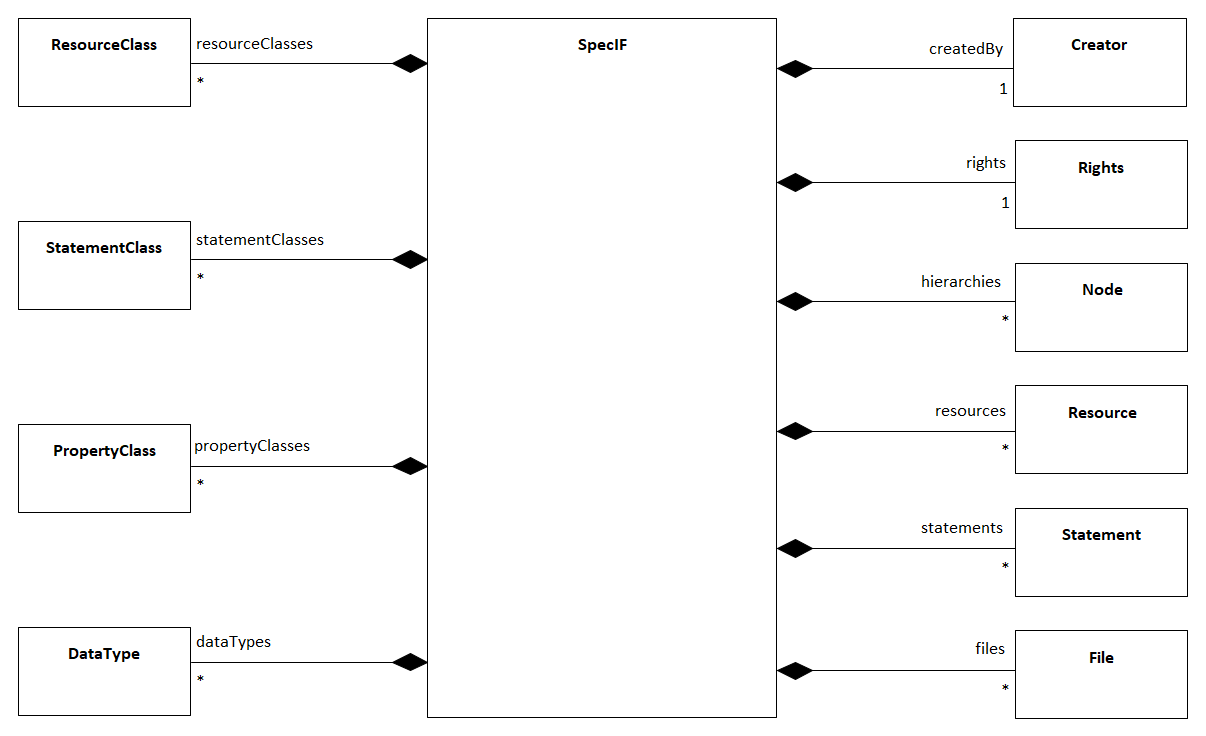
The SpecIF class is the outermost element of a SpecIF data representation. We can call it a repository or data set. It defines the entire SpecIF data set represented in platform-specific implementation by a SpecIF file or a SpecIF persistence layer like a database or data provided by a Web API. Such a SpecIF repository instance is often identical with a project context in a development project. It can contain the entire content of PLM data created in a project context.
SpecIF allows the selected and distributed inclusion of data into a SpecIF repository.
It is not required to have all data, that can be stored in a SpecIF data set, in a single repository.
Therefore, you can have one SpecIF repository containing the data and class definitions, and a second, separated set containing the data content, but referencing the required data types by the unique identifiers.
A SpecIF instance has a boolean attribute called isExtension.
If this value is set to true, a tool, that is working with this data, needs further SpecIF data to get the complete definition of all required data types and data type definitions.
SpecIF-Repository description attributes
To express additional information about the SpecIF repository resp. the project data represented by SpecIF, the metamodel defines some attributes for describing the SpecIF metaclass.

SpecIF
The SpecIF metaclass has the following attributes:
- id: string - A unique identifier for the SpecIF repository resp. the project represented by the SpecIF repository/file.
- title: MultilanguageText[] - A human readable description for the entire SpecIF repository/project.
- description: MultilanguageText[] - A human readable description for documentation purposes.
- isExtension: bool - Indicates that the project is not schema-compliant on its own; by default the value is ‘false’. Of course, it is expected that once extended the project is schema-compliant.
- generator: string - The generator that generates the SpecIF data.
- generatorVersion: string - The SpecIF generator tool version.
- language: string - An IETF language tag such as ‘en’, ‘en-US, ‘fr’ or ‘de’ showing the used language of simple property values. Is superseded by a resource’s, statement’s or property’s language value.
- createdAt: DateTime - The creation date.
- createdBy: Creator - The creator of the SpecIF data set. If specified, at least an e-mail address must be given.
- rights: Rights - Copyright and/or license information.
Creator
The Creator metaclass defines information about the SpecIF data creator.
It has the following attributes:
- familiyName: string - The creator’s family name.
- givenName: string - The creator’s given name.
- email: string - The creator’s e-mail.
- org: Org - The creator’s organization.
Org
The Org metaclass describes the SpecIF creator’s organization and has the following attribute:
- organizationName: string - The organization name.
Rights
The Rights metaclass defines a data structure to represent copyright and/or license information about the SpecIF data. It has the following attributes:
- title: string - A title for the copyright/license information (e.g. ‘Apache license v2’).
- url: string - A valid uniform resource locator to further copyright/license information.
Data representation and data type definitions in SpecIF
In SpecIF it is possible to define concrete data using the concept of graph data, represented by the metaclasses Resource (as graph nodes) and Statement (as graph edges). These two elements can contain Property elements to store a set of data elements (e.g. a title and a description). A property has a well defined (primitive) data type (e.g. string, integer etc.). This allows a tool to present, edit and validate property data using specialized editors for numbers, text or formatted text.
The elements containing the data need a specification about data structure and data types. This is done in SpecIF by defining a set of classifiers for the concrete data. These classifiers define for example what kind of properties are included in a resource element called ‘Requirement’.
The SpecIF-Metamodel defines a set of classes that are responsible for these data type definitions:
- The ResourceClass defines the type of a Resource.
- The StatementClass defines the type of a Statement.
- The PropertyClass defines the type of a Property.
- The DataType defines the primitive data types (Integer, String, Double, Boolean, DateTime, Enumerations) used as data types for property definitions. The type string can represent formatted text or unformatted text.
Metamodel helper classes
The SpecIF metamodel defines three helper classes. They are described in this section.
Base Element
Some attributes in the metamodel are common for multiple metaclasses. We define this in an abstract metaclass BaseElement.
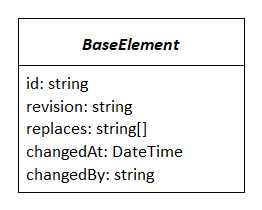
- id: string - A unique identifier for the SpecIF element.
- revision: string - A unique identifier for the revision of the SpecIF element.
- replaces: string[] - The revision IDs of the SpecIF elements replaced by this element revision. This array has a maximum length of 2 entries and can contain 0 entries (no predecessor), 1 entry (1 predecessor) or 2 entries (this element is merged from 2 predecessors).
- changedAt: DateTime - The date and time when the element was changed.
- changedBy: string - The change author.
The following metaclasses are inherited from BaseElement:
- DataType,
- PropertyClass,
- ResourceClass,
- StatementClass,
- Resource,
- Statement,
- Node,
- File.
Remark: The attributes of the base metaclass BaseElement are not set for each child class any more!
MultilanguageText

To realize the concept of data storage in multiple languages, SpecIF defines a metaclass called MultilanguageText.
This class defines three attributes:
- text: string - This attribute contains the data content in a certain language.
- format: TextFormat - An enumeration value describing the text format. Allowed values are plain for plain text or xhtml for formatted content.
- language: string - An IETF language tag such as ‘en’, ‘en-US, ‘fr’ or ‘de’ showing the used language.
Typically an array of these MultilanguageText objects is used to represent a value in multiple languages. Each single array value contains the same text content but in a specific language (english, german, etc.).
EnumeratedValue
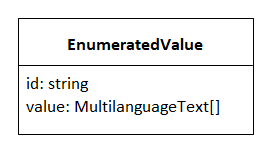
To define enumerations in SpecIF the metaclass EnumerationValue is used to define the values for enumerations in data types. In SpecIF different data types can be defined as enumerations by defining a set of predefined values. This is done using the EnumeratedValue class.
This class defines two attributes:
- id: string - An identifier for the enumeration value. This ID must be unique within the collection of enumeration values for an enumeration data type definition.
- value: MultilanguageText[] - The enumeration value definition in multiple languages.
AlternativeId
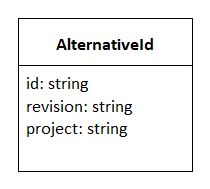
AlternativeId data values are used to further define identifier values in addition to the id attribute in SpecIF. This is helpful for data integrations where multiple tools use their own internal identifiers. So you can represent these ‘legacy’ IDs in SpecIF. AlternativeId has the following attributes:
- id: string - A string with a valid identifier of an element.
- revision: string - A unique revision identifier.
- project: string - A string with a valid project identifier.
SpecIF-Metamodel details
The figure below shows the metamodel with properties and associations between elements to represent data representation, data type definitions and hierarchical structures.
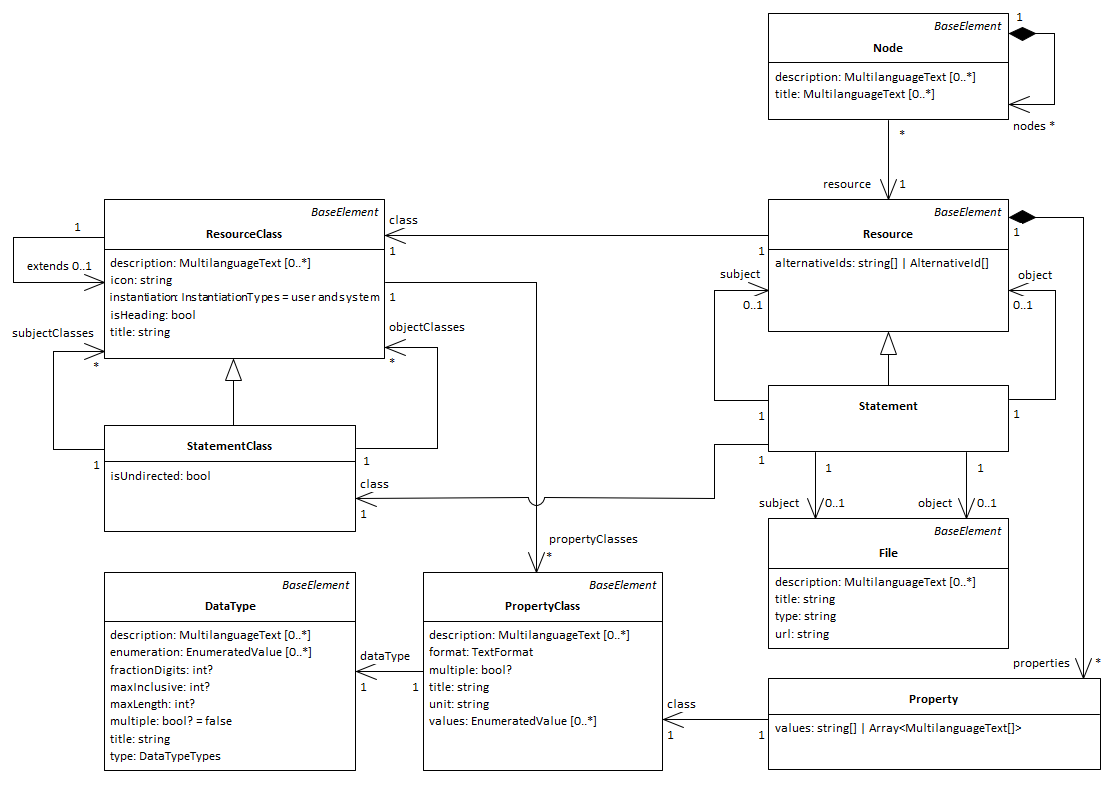
On the right you can see the classes defining the data structures for concrete data elements like Resource, Statement, Property, Hierarchy and Node. On the left you can see the data type defining elements like ResourceClass, StatementClass, PropertyClass and DataType.
In the following sections the semantics of all elements is described in detail.
DataType
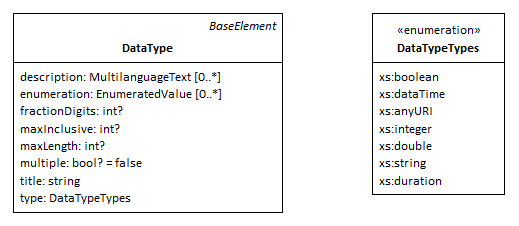
A DataType is used to define the base data types (primitive data types) on which all other type definitions are based. SpecIF allows the definition of primitive data types for numbers, formated or unformatted text strings, DateTime values and enumerations. So the DataType metaclass defines the following attributes to satisfy these requirements:
- title: string - A unique name for the defined data type (e.g. ‘string’).
- description: MultilanguageText[] - A human readable description of the data type for documentation purposes.
- type - A formal definition of the used base type. The allowed types are taken from the XML-stylesheet-standard (https://www.w3.org/TR/xmlschema11-1/) and defined in the metamodel as Enumeration DataTypeTypes as follows:
- xs:boolean,
- xs:integer,
- xs:double,
- xs:string,
- xs:anyURI,
- xs:dateTime,
- xs:duration.
- maxInclusive - The maximum value for a numeric data type.
- fractionDigits - The number of digits for floating point numbers.
- enumeration - A list of enumerated values.
- multiple: bool - This flag indicates for enumeration definitions, that a multiple selection of enumeration values should be possible.
- maxLength: int - The maximum length of a text value.
It is possible to restrict the possible values for a data type. Enumerated data types can be defined and used in this manner. The allowed values are defined by the attribute enumeration using a list of EnumeratedValue elements.
Enumerations may be defined for all data types (except for boolean which is an enumeration itself), so it is possible to define a set of strings as enumeration, a set of numbers or a set of any other base type. This might be helpful for example to define a data type for story points used in agile project management, often defined as Fibonacci numbers.
Note that in a SpecIF data set the values of all data types are represented as strings, even the numbers. So, a SpecIF value is always a string, no matter which dataType it has.
PropertyClass

A PropertyClass defines the type of a SpecIF property. Properties are used to define data of resource and statement elements. The PropertyClass has the following attributes:
- title: string - A unique name for the defined PropertyClass (e.g. ‘dcterms:title’).
- description: MultilanguageText[] - A human readable description of the data type for documentation purposes.
- multiple: bool - This flag indicates that the property value can hold multiple values (multiple enumeration values or an array of primitive data).
- dataType - This association references the used DataType for the ProperyClass.
ResourceClass
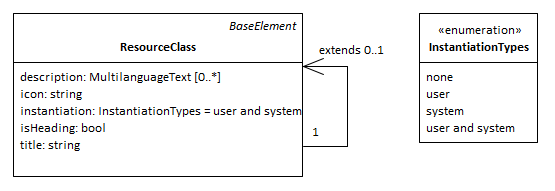
A ResourceClass is used to define the type of a SpecIF resource instance. SpecIF resource classes can inherit properties from othe resource classes. Inheritance is indicated by an attribute extends pointing to other existent resource class elements. Properties of the inherited class apply plus the properties defined by the given class itself - just like inheritance concepts in object oriented data modeling and programming.
The ResourceClass has the following attributes:
- title: string - A unique name for the defined ResourceClass (e.g. ‘IREB:Requirement’).
- description: MultilanguageText[] - A human readable description of the data type for documentation purposes.
- icon: string - An icon definition usable by authoring tools for resources. This can be a (short) character string, a UTF-8 code of a symbol or an image encoded as Base64 data URL.
- isHeading: bool - Indicates that the defined resource is a heading.
- instantiation: InstantiationTypes - Values: ‘user’ and/or ‘system’. Indicates whether an instance of the class is created automatically, manually or both. All is allowed by default. The class is abstract and cannot be instantiated, if the value is set to ‘none’.
- extends - Reference to a parent resource class element when inheritance is used in the data definition.
- propertyClasses - A list of property class references to define which properties shall be used for the given resource class.
StatementClass

A StatementClass defines the type of a SpecIF statement instance. Inheritance from other statement classes using the extends attribute is possible, as well. Statements are the edges in a SpecIF graph and are in fact semantic relations between resources. A statement has two ends called subject and object. An example is “system-component-IJK satisfies requirement-345”. A StatementClass may define eligible resource classes for the subject an object of the statement instances. This is done by referencing the allowed subject ResourceClass elements and object ResourceClass elements. Restricting the eligible resource classes forboth subject and object of a statement can effectively exclude meaningless, misleading or even false statements.
The StatementClass has the same attributes as a ResourceClass and in addition:
- isUndirected: bool - This flag indicates that a statement defined by this statement class has no direction. The ‘subject’ and ‘object’ of the statement are interchangeable without changing the meaning. For example, if two terms represented as a resource are synonyms, a statement indicating that fact is undirected.
- subjectClasses - A collection of references to ResourceClass elements to define the allowed classes for the statement’s subject. If the subjectClasses list is missing, subjects of all resource classes are eligible. If it is present, it may not be empty.
- objectClasses - A collection of references to ResourceClass elements to define the allowed classes for the statement’s object. If the objectClasses list is missing, subjects of all resource classes are eligible. If it is present, it may not be empty.
Property

A Property is an instance of a PropertyClass and is used to store a concrete data value in SpecIF. Each property in SpecIF is defined as an array of values. The attribute isMultiple in the PropertyClass specifies if a property value is an array or a single value.
If isMultiple is set to false and the property attribute values contains more than one value, only the first value shall be used and all other array elements shall be ignored!
Depending on the DataType, that is used as definition of the PropertyClass, each value of the array is either a MultilanguegeText for plain or xtml-textual content or a string for all other contents (e.g. numbers, enumerations etc.). For enumerations the ID of the EnumerationValue is stored as property value.
A property has the following attributes:
- values - The values of the property to store the property content data (multiple or single values).
- class - A reference to the PropertyClass element defining the property type.
Resource
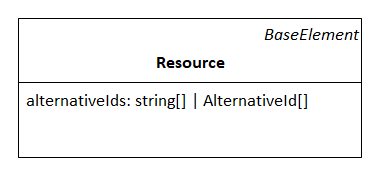
A Resource is an instance of a PropertyClass and the element in SpecIF that represents a node in the graph data structure. Resources represent all kind of concrete data in PLM. This might be a requirement, a model element in UML or SysML or an electrical circuit in an E-CAD model etc.
A resource has the following attributes:
- alternativeIds - Alternative ID values are used to define further ID values in addition to the id attribute in SpecIF. This is helpful for data integrations where multiple tools have their own internal IDs. So you can represent these ‘legacy’ IDs in SpecIF.
- class - A reference to the ResourceClass element defining the resource type.
- properties - A collection of property elements to store property data for the resource.
Statement
A Statement is an instance of a StatementClass and the element in SpecIf that defines the edge in the graph data structure. Statements allow to define predicate logic in form of Subject - Predicate - Object. The subject and the object are resources, statements of file elements, the predicate is always a statement.
A statement is inherited from a resource and has the following additional attributes:
- subject - A reference to the resource, statement or file that is used as subject for the statement.
- object - A reference to the resource, statement or file that is used as object for the statement.
Node
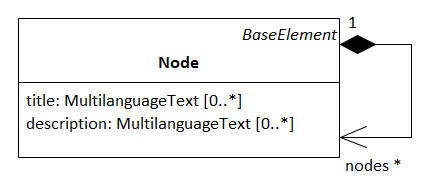
The metaclass Node allows to define hierarchical data structures (trees) in SpecIF. Typical application scenarios are hierarchical structures in textual specifications like documents and the structures in CAD and other modeling tools.
The data is not directly included inside node elements. Instead, the resources of a node are just included via reference. This allows a separation of data model and view (view concept as known e.g. from UML-tools) and the inclusion of the same resource elements into multiple hierarchy trees.
The node element have the following attributes:
- title: MultilanguageText[] - A title for the node. Mostly used for internal purposes, because the title normally comes from the referenced resource element properties.
- description: MultilanguageText[] - A human readable description for documentation purposes. Mostly used for internal purposes, because the description normally comes from the referenced resource element properties.
- nodes - A collection of child node elements for the node.
- resource - A reference to the resource element used as Node tree node data.
File
The last remaining element to describe is the File metaclass. SpecIF allows the inclusion of any kind of file into the repository. This allows for example to add files as attachments to a SpecIF specification etc. The File element allows to describe and reference files contained in a SpecIF repository.

The metaclass File has the following attributes:
- title: string - In case of a file, the title is the absolute or relative URL.
- description: MultilanguageText[] - A human readable description for documentation purposes.
- type: string - The file’s media type (formerly MIME-type) according to https://www.iana.org/assignments/media-types/media-types.xhtml.
- url: string - An absolute or relative URL to the file. If missing, the title applies.